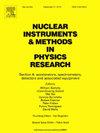Operation and performance of the ALICE Muon IDentifier RPCs during LHC Run3
IF 1.5
3区 物理与天体物理
Q3 INSTRUMENTS & INSTRUMENTATION
Nuclear Instruments & Methods in Physics Research Section A-accelerators Spectrometers Detectors and Associated Equipment
Pub Date : 2025-04-22
DOI:10.1016/j.nima.2025.170518
引用次数: 0
Abstract
ALICE (A Large Ion Collider Experiment) investigates quark–gluon plasma (QGP) in ultrarelativistic heavy-ion collisions at the LHC. A key observable for QGP studies is heavy-quark hadron production in Pb–Pb collisions, detected via their muonic decays using a forward muon spectrometer (MS). During LHC Runs 1 and 2, a muon trigger system based on Resistive Plate Chambers (RPCs) was used. Since the start of Run 3, ALICE is working in continuous readout (triggerless) mode, and the muon trigger system was replaced by the Muon Identifier (MID). To mitigate aging and enhance RPC rate capability, the working voltage was reduced while maintaining the same gas mixture, alongside upgraded front-end and readout electronics. This paper assesses the stability and performance of MID RPCs over the first 2.5 years of Run 3 at unprecedented collision energies.
ALICE介子标识符rpc在LHC运行期间的运行和性能
ALICE(大型离子对撞机实验)在大型强子对撞机的超相对论性重离子碰撞中研究夸克-胶子等离子体(QGP)。QGP研究的一个关键观测结果是Pb-Pb碰撞中重夸克强子的产生,通过使用前向μ子光谱仪(MS)通过它们的μ子衰变来检测。在LHC 1和2次运行中,使用了基于电阻板室(rpc)的介子触发系统。自运行3开始,ALICE工作在连续读出(无触发)模式,并且μ子触发系统被μ子标识符(MID)取代。为了减缓老化并提高RPC速率,在保持相同气体混合物的同时降低了工作电压,同时升级了前端和读出电子设备。本文评估了在Run 3的前2.5年中,在前所未有的碰撞能量下,MID rpc的稳定性和性能。
本文章由计算机程序翻译,如有差异,请以英文原文为准。
求助全文
约1分钟内获得全文
求助全文
来源期刊
CiteScore
3.20
自引率
21.40%
发文量
787
审稿时长
1 months
期刊介绍:
Section A of Nuclear Instruments and Methods in Physics Research publishes papers on design, manufacturing and performance of scientific instruments with an emphasis on large scale facilities. This includes the development of particle accelerators, ion sources, beam transport systems and target arrangements as well as the use of secondary phenomena such as synchrotron radiation and free electron lasers. It also includes all types of instrumentation for the detection and spectrometry of radiations from high energy processes and nuclear decays, as well as instrumentation for experiments at nuclear reactors. Specialized electronics for nuclear and other types of spectrometry as well as computerization of measurements and control systems in this area also find their place in the A section.
Theoretical as well as experimental papers are accepted.

 求助内容:
求助内容: 应助结果提醒方式:
应助结果提醒方式:


